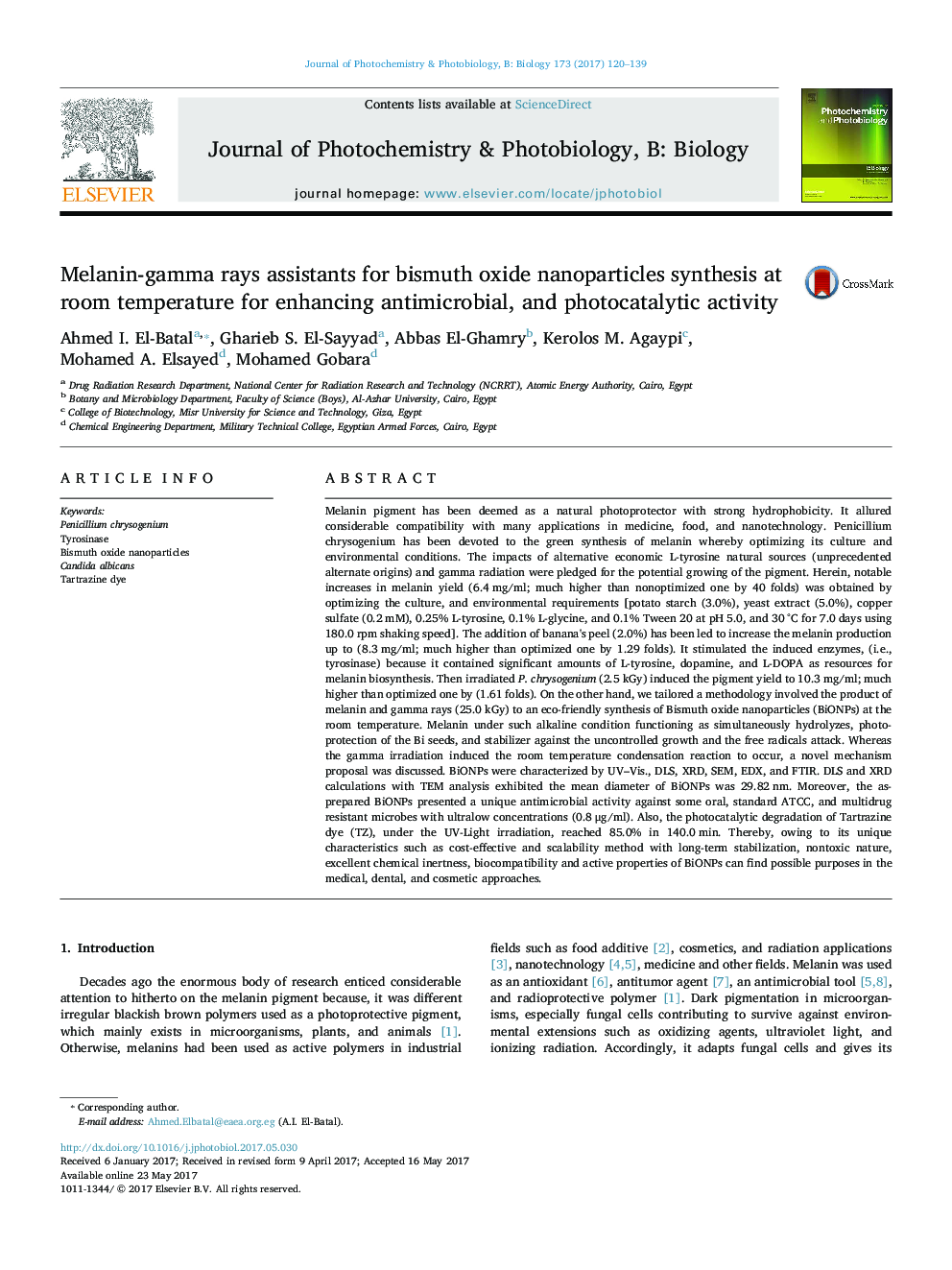| کد مقاله | کد نشریه | سال انتشار | مقاله انگلیسی | نسخه تمام متن |
|---|---|---|---|---|
| 4754371 | 1418060 | 2017 | 20 صفحه PDF | دانلود رایگان |
- Classical optimization of the melanin synthesis by P. chrysogenium, was increased up to 6.335Â mg/ml.
- The impact of banana peel and, gamma irradiation on melanin production enhances the yield to 8.3 and 10.24Â mg/ml, respectively.
- A novel mechanism for synthesis of BiONPs using melanin with gamma rays at room temperature was discussed.
- BiONPs shows a photo-catalytic activity for selected organic dye degradation.
- BiONPs shows broad spectrum antimicrobial properties against some selected pathogenic microbes.
Melanin pigment has been deemed as a natural photoprotector with strong hydrophobicity. It allured considerable compatibility with many applications in medicine, food, and nanotechnology. Penicillium chrysogenium has been devoted to the green synthesis of melanin whereby optimizing its culture and environmental conditions. The impacts of alternative economic L-tyrosine natural sources (unprecedented alternate origins) and gamma radiation were pledged for the potential growing of the pigment. Herein, notable increases in melanin yield (6.4 mg/ml; much higher than nonoptimized one by 40 folds) was obtained by optimizing the culture, and environmental requirements [potato starch (3.0%), yeast extract (5.0%), copper sulfate (0.2 mM), 0.25% L-tyrosine, 0.1% L-glycine, and 0.1% Tween 20 at pH 5.0, and 30 °C for 7.0 days using 180.0 rpm shaking speed]. The addition of banana's peel (2.0%) has been led to increase the melanin production up to (8.3 mg/ml; much higher than optimized one by 1.29 folds). It stimulated the induced enzymes, (i.e., tyrosinase) because it contained significant amounts of L-tyrosine, dopamine, and L-DOPA as resources for melanin biosynthesis. Then irradiated P. chrysogenium (2.5 kGy) induced the pigment yield to 10.3 mg/ml; much higher than optimized one by (1.61 folds). On the other hand, we tailored a methodology involved the product of melanin and gamma rays (25.0 kGy) to an eco-friendly synthesis of Bismuth oxide nanoparticles (BiONPs) at the room temperature. Melanin under such alkaline condition functioning as simultaneously hydrolyzes, photoprotection of the Bi seeds, and stabilizer against the uncontrolled growth and the free radicals attack. Whereas the gamma irradiation induced the room temperature condensation reaction to occur, a novel mechanism proposal was discussed. BiONPs were characterized by UV-Vis., DLS, XRD, SEM, EDX, and FTIR. DLS and XRD calculations with TEM analysis exhibited the mean diameter of BiONPs was 29.82 nm. Moreover, the as-prepared BiONPs presented a unique antimicrobial activity against some oral, standard ATCC, and multidrug resistant microbes with ultralow concentrations (0.8 μg/ml). Also, the photocatalytic degradation of Tartrazine dye (TZ), under the UV-Light irradiation, reached 85.0% in 140.0 min. Thereby, owing to its unique characteristics such as cost-effective and scalability method with long-term stabilization, nontoxic nature, excellent chemical inertness, biocompatibility and active properties of BiONPs can find possible purposes in the medical, dental, and cosmetic approaches.
237
Journal: Journal of Photochemistry and Photobiology B: Biology - Volume 173, August 2017, Pages 120-139
